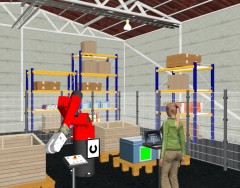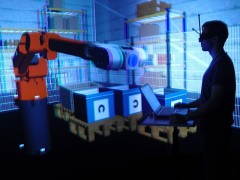- Artificial Intelligence (AI)
- Occupational exposure limit values
- Climate Change and Occupational Safety
- List of CMR substances
- Electromagnetic fields
- Ergonomics
- Industrial Security
- Collaborative robots
- Noise
- Nanoparticles at the workplace
- Optical Radiation
- REACH
- Reference materials
- Proficiency testing
- Vibration
- Virtual reality
- Work 4.0
Design of the system ergonomics

Virtual test scenario for study of the influence of the robot's distance and speed
Source: IFA
International standards for collaborative industrial robots and the relevant recommendations of the DGUV and IFA state general ergonomic safety objectives for robot workplaces. For example, the perception, attention and thought processes of the human operative must not be impaired or disturbed by the work environment and the collaborative robot. To date however, more precise specifications of the measures by which this and similar objectives can be achieved have not been available. A joint project (ESiMiP, sponsored by the Bavarian Research Foundation) therefore examined what design aspects of human-robot collaboration are conducive to the attainment of these objectives.
With reference to the existing literature, the IFA first identified basic variations in the design of human-robot collaboration that had the potential to influence the performance and well-being of persons working with the robot. These variations include:
- Distance between the human being and the robot
- Speed of the robot
- Trajectory of the robot's movement
- Angle of approach of the tool centre point (robot tool position)
- Acceleration of the robot
- Dimensions of the robot
- Positioning of the robot relative to the person
- Attractiveness of the robot
- Exchange of information between the person and the robot
Experimental simulation studies were then conducted on test persons in virtual reality to examine how selected variations in design influence processes of human information processing and thus also human behaviour and performance.
Example test arrangement
An industrial work scenario involving a collaborative robot was simulated in the IFA's SUTAVE laboratory. Tasks modelling the cognitive processes of activities in industrial manufacturing and quality control were completed by test persons in conjunction with a virtual robot. The following experimental factors were varied in the tests:
- Robot speed (25 cm/s; 75 cm/s; 150 cm/s)
- Distance from the worker (30 cm; 140 cm)
- Trajectory of the robot's movement (predictable; unpredictable)
The influence of these three design variations upon the human being was recorded and evaluated with reference to dimensions of performance and perception.
Results and practical benefit
The results of these studies showed that a smaller distance to the robot, higher robot speeds and unpredictable trajectories impacted unfavourably upon the strain, performance and well-being of the test persons.
These results are relevant to the safety and health of workplaces involving collaborative robots, for a number of reasons: increased strain increases the probability of human error, a potential cause of accidents; increased strain may also impact negatively upon health in the long term; poor well-being may lead to loss of user acceptance, and therefore also to the willingness to observe safety regulations.
Empirical results such as those presented here can supplement recommendations and international standards for the design and operation of collaborative robot systems and support the design of safe and healthy workplaces of this kind.
For download

Koppenborg, M.; Naber, B.: How should workplaces involving collaborative robots be designed? Focus on IFA's work No. 0348 (PDF, 126 kB, non-accessible)
Koppenborg, M.; Lungfiel, A.; Naber, B.; Nickel, P.: Auswirkung von Autonomie und Geschwindigkeit in der virtuellen Mensch-Roboter-Kollaboration (PDF, 1.9 MB, non-accessible) . Chancen durch Arbeits-, Produkt- und Systemgestaltung - Zukunftsfähigkeit für Produktions- und Dienstleistungsunternehmen. 59. Kongress der Gesellschaft für Arbeitswissenschaft, 27. Februar bis 1. März 2013, Krefeld - Vortrag. Berichtsband und CD-ROM, S. 417-420. Hrsg.: Gesellschaft für Arbeitswissenschaft, GfA-Press, Dortmund 2013 (in German)
Contact
Accident Prevention: Digitalisation - Technologies
Tel: +49 30 13001-3514Fax: +49 30 13001-38001
